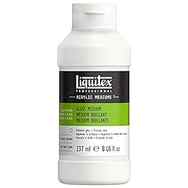Sometimes it is best to take the extra precautions to make sure the painting results are maximized. Save time, materials, and money by doing it the right way, instead of having to repeat your work over and over.
Is Acrylic Paint Waterproof?

This post may contain affiliate links, which means I may earn a commission if you decide to purchase through my links.
Maybe you’re working on an outdoors art project and want to be sure that your acrylic painting doesn’t wash away in the rain. Maybe you’re working on a piece for your bathroom and don’t want the moisture to turn your new piece of art into a dripping mess. Or, maybe you just want to have piece of mind that when your toddler inevitably splashes his water all over the family room that you made a good choice in choosing acrylic paint that will survive the chaos. So, is acrylic paint actually waterproof?
When dry, acrylic paint isn’t fully waterproof. It is water resistant and can stand up pretty well to water, but it can degrade overtime. To preserve your acrylic paint works, it’s best to varnish them so that they withstand the test of time.
Acrylic paint is pretty sturdy as far as art paint goes. Unless you want to make your paintings with weather-resistant house paint, acrylic paint is a good choice for projects that might get a little wear and tear. That said, it isn’t indestructible and there are things you should know if you want your acrylic artworks to be at their best. First, let’s talk about how acrylic paint is made and why it can degrade overtime. Then, we’ll talk about varnishes you can use to protect your acrylic paintings.
What is Acrylic Paint Made Out Of?
Acrylic paint is made out of pigment, acrylic resin, and water.
Pigment – this is what creates the color in acrylic paint. The problem is that pigment is a powder in its natural form, so it needs some help to become a usable paint.
Acrylic resin – this is a binder that helps separate the pigment and keep it in place on the surface of your painting once it dries. It “binds” everything together (source).
Water – this is a vehicle that helps keep the binder and the pigment fluid. It’s a “vehicle” for the pigment and binder.
When the acrylic resin and water are mixed together, they make an acrylic polymer emulsion. After you finish your painting, the water evaporates and the acrylic resin turns into a sort of plastic. At this point, your painting is finished and the paint is set (source).

Acrylic Paint is Water Resistant
There’s actually debate as to whether acrylic paint is water resistant or whether it’s fully waterproof. As for me, I’m landing on the water resistant side of things. Here’s why.
To start things off, we need to understand the difference between water resistant and waterproof.
Water resistant – able to resist penetration by water, but not entirely
Waterproof – can withstand water no matter what, regardless of how much water it is and how much time it spends in the water (source).
Acrylic paint is a polymer. Polymers are often used to create waterproof coatings. So, that’s why acrylic paint is said to be waterproof and, in reality, is incredibly durable when exposed to water. But, personally, I have an issue with the word “waterproof.”
Objects that are waterproof come with a rating, it starts with an “IP” and indicates how waterproof that object is. What’s acrylic paint’s waterproof rating? It doesn’t have one that I can see. So, how are we supposed to know just how waterproof acrylic paint actually is?
I don’t know if I would feel comfortable throwing my acrylic painting to the bottom of the pool and leaving it there for an hour. I also don’t know if I want to put my beautifully painting mailbox out in a rainstorm without protection.
That’s why I’m in the water resistant camp. Yes, your acrylic work will be resistant to water, which means it will hold up pretty well to the elements, but it may not be fully bulletproof to them though. If you’ve worked really hard on something, why take the risk?
Why Do You Need to Waterproof Acrylic Paint?
Acrylic can be thinned out with water since it is a water-based paint.
If you do not make your piece waterproof, it could be ruined by a decent amount of water. Any items that are to be kept for outdoors must be waterproofed to keep them safe from the rain and the dew.
Acrylic paint is porous. It will slowly absorb water into the tiny pores. You will not even notice this happening until it’s too late and it becomes ruined.
How Do You Waterproof Acrylic Paint?
To make acrylic paint waterproof, you will need to apply a sealer such as a varnish, for example.
There are spray sealers that are the most commonly used in the art world. The sealer will protect the coat of acrylic paint from the elements.
I like to either use an acrylic sealer or a varnish to seal my acrylic paints.
My favorite Acrylic Sealer is the Plaid Mod Podge Clear Acrylic Sealer (Link to Amazon). It is easy to apply and the fact, that it is a spray sealer makes it even easier to cover your whole project in a thin coat. You can apply multiple coats without any problems the sealer will still be clear even after multiple layers.
The other way to Seal your acrylic paints is with a varnish. If you want to seal painted wood then this is the way to go. But you can seal any other painted project with varnish too. I would recommend using Gamblin Gamvar Varnish. It is a gloss varnish for sealing wood and a wide range of paints including acrylic paints. You can get a spray Varnish as well. It will make applying the varnish quite a lot easier.
It will not be able to absorb the water into the pores. That will prolong the life of your item.
To get maximized results, it is best to first use a water-based sealer and then add a layer of oil-based sealer. To give an extra seal, you can add a drying oil to your item.
Be sure to leave it sitting for around 3 days or so to completely dry. Your art will be remarkable, durable, and safe.
Is Acrylic Paint Used Just for Paintings?
Acrylic paint is used on many items other than just canvas.
There are many materials that acrylics can be used to enhance such as wood, plastics, stretchy vinyl, ceramics, glass, etc.
This type of paint is many people’s favorite type for the simple fact that it is so adaptable. There are additives such as pastes, powders, and gels that can be mixed in it to give it a matte or glossy outcome.
You can make any item your style by changing the way it appears. Acrylic paint is perfect for crafting different items because it is so adaptable. It will generally work well on any item that isn’t oily.





